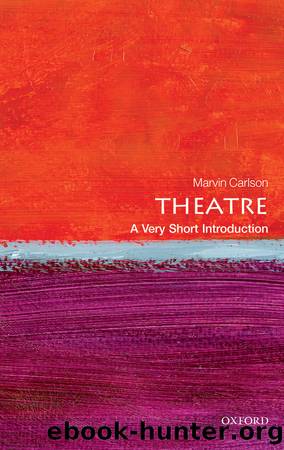Theatre: A Very Short Introduction by Marvin Carlson

Author:Marvin Carlson [Carlson, Marvin]
Language: eng
Format: epub
ISBN: 9780199669820
Publisher: Oxford University Press
Published: 2014-08-27T00:00:00+00:00
The regulation of texts
The publication of dramatic texts presented an opportunity for a much wider circulation of these texts theatrically, since alternative venues no longer needed to rely upon the highly unstable pirated versions, but in fact such circulation was severely limited during the 17th and 18th centuries. During those centuries, published versions were intended for reading or in some cases for the use of amateur groups, since the only professional production of most published plays was confined by strict governmental regulation to the particular state-sponsored theatres where these plays were created. As early as 1402, the Confrérie de la Passion was granted a monopoly on the performance of religious plays in Paris, and in 1582, although specifically religious plays were no longer allowed, this company was the single group allowed to perform plays within Paris or its vicinity. Thus the precedent was established from the beginning of the European Renaissance for the Comédie Française and for the many European national theatres established upon the same general model to have their own repertoire of plays, which no other theatre could present. Thus, until the Revolution, only the Comédie was permitted to present the work of Molière, Racine, and the many other dramatists whose work was first presented by that company.
This governmental practice reinforced a far closer and more ongoing relationship between individual dramatic texts and their stage interpretation than has been the case since the rise of Romanticism. The almost universal model of theatre organization in the West, and especially in Europe, has traditionally followed that model found wherever in the world ongoing professional theatres have been established. Such theatres almost invariably have had at their core a group of actors, in some cases related family members, who work together over a long period of time, perhaps for decades. Like other crafts and trades, theatre has often operated through some form of the masterâapprentice system, with new members of the company being trained by the older and established members, with the general expectation that they would in turn succeed those mentors and become themselves mentors of the next generation. Their instruction would as a rule not only involve general physical and vocal techniques, but a particular way of performing a particular play, even a particular role or type of role. The Noh theatre is especially well known for its carefully preserved performance tradition, with essentially the same gestures, costumes, and movement accompanying the same words in performance after performance of the same work. Up until the late 18th century, and in some cases through the 19th, most Western theatres also followed a similar if somewhat less strict preservation of particular performance techniques. Not only were young actors trained in certain âlines of businessâ as the English called them, or emplois according to the French, placing them in such general categories as witty maids, ingénues, or irascible old men, but each type and often even each particular character in a particular play utilized movements, even gestures and line readings that were faithfully passed down, like the movements in Noh, from master to apprentice.
Download
This site does not store any files on its server. We only index and link to content provided by other sites. Please contact the content providers to delete copyright contents if any and email us, we'll remove relevant links or contents immediately.
Kathy Andrews Collection by Kathy Andrews(11674)
The remains of the day by Kazuo Ishiguro(8733)
Paper Towns by Green John(5021)
Spare by Prince Harry The Duke of Sussex(4990)
The Body: A Guide for Occupants by Bill Bryson(4876)
Industrial Automation from Scratch: A hands-on guide to using sensors, actuators, PLCs, HMIs, and SCADA to automate industrial processes by Olushola Akande(4825)
Machine Learning at Scale with H2O by Gregory Keys | David Whiting(3941)
Be in a Treehouse by Pete Nelson(3874)
Harry Potter and the Goblet Of Fire by J.K. Rowling(3733)
Never by Ken Follett(3697)
Goodbye Paradise(3658)
Into Thin Air by Jon Krakauer(3256)
The Remains of the Day by Kazuo Ishiguro(3249)
The Cellar by Natasha Preston(3214)
The Genius of Japanese Carpentry by Azby Brown(3185)
Fairy Tale by Stephen King(3150)
120 Days of Sodom by Marquis de Sade(3110)
Drawing Shortcuts: Developing Quick Drawing Skills Using Today's Technology by Leggitt Jim(2958)
The Man Who Died Twice by Richard Osman(2950)
